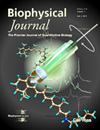Chromatin Compaction Scaling with Cell Size Follows a Power Law from Interphase Through Mitosis.
IF 3.1
3区 生物学
Q2 BIOPHYSICS
引用次数: 0
Abstract
Coordination of mitotic chromosome compaction with cell size is crucial for proper genome segregation during mitosis. During development, DNA content remains constant but cell size changes dynamically, necessitating a mechanism that scales chromosome compaction with cell size to ensure proper chromatin segregation. In this study, we examined chromatin compaction in the developing Drosophila nervous system by analyzing the large neuronal stem cells and their smaller progeny, the ganglion mother cells. Using super-resolution 3D Stochastic Optical Reconstruction Microscopy and quantitative time-lapse fluorescence microscopy, we observed that nanoscale chromatin density during interphase scales with nuclear volume according to a power law. This scaling relationship is disrupted by inhibiting histone deacetylase activity, indicating that molecular cues rather than mechanical constraints primarily regulate chromatin compaction. Notably, this power law dependency is maintained into mitosis but the scaling exponent decreases. This suggests a phase separation-like transition in the biophysical state of chromatin, whereby the polymer shifts from a more expanded to a more compact configuration. Accordingly, we propose that the scaling of mitotic chromosome size relative to cell size emerges from the organisational principles of interphase chromatin, and that mitotic compaction may be governed by polymer properties modulated by changes in the chromatin - solvent environment.染色质压实度随细胞大小的变化遵循从间期到有丝分裂的幂律。
有丝分裂过程中,有丝分裂过程中染色体压实与细胞大小的协调对基因组分离至关重要。在发育过程中,DNA含量保持不变,但细胞大小是动态变化的,这就需要一种机制,可以根据细胞大小来调整染色体的压实程度,以确保适当的染色质分离。在这项研究中,我们通过分析大的神经干细胞及其较小的后代,神经节母细胞,研究了发育中的果蝇神经系统的染色质压实。利用超分辨率三维随机光学重建显微镜和定量延时荧光显微镜,我们观察到核体积间期纳米级染色质密度按幂律变化。这种缩放关系通过抑制组蛋白去乙酰化酶活性而被破坏,表明分子线索而不是机械约束主要调节染色质压实。值得注意的是,这种幂律依赖关系保持到有丝分裂,但标度指数下降。这表明在染色质的生物物理状态中存在一种类似相分离的转变,即聚合物从更膨胀的结构转变为更紧凑的结构。因此,我们提出有丝分裂的染色体大小相对于细胞大小的缩放来自于间期染色质的组织原理,并且有丝分裂的压实可能是由染色质溶剂环境变化所调节的聚合物特性所控制的。
本文章由计算机程序翻译,如有差异,请以英文原文为准。
求助全文
约1分钟内获得全文
求助全文
来源期刊

Biophysical journal
生物-生物物理
CiteScore
6.10
自引率
5.90%
发文量
3090
审稿时长
2 months
期刊介绍:
BJ publishes original articles, letters, and perspectives on important problems in modern biophysics. The papers should be written so as to be of interest to a broad community of biophysicists. BJ welcomes experimental studies that employ quantitative physical approaches for the study of biological systems, including or spanning scales from molecule to whole organism. Experimental studies of a purely descriptive or phenomenological nature, with no theoretical or mechanistic underpinning, are not appropriate for publication in BJ. Theoretical studies should offer new insights into the understanding ofexperimental results or suggest new experimentally testable hypotheses. Articles reporting significant methodological or technological advances, which have potential to open new areas of biophysical investigation, are also suitable for publication in BJ. Papers describing improvements in accuracy or speed of existing methods or extra detail within methods described previously are not suitable for BJ.
 求助内容:
求助内容: 应助结果提醒方式:
应助结果提醒方式:


